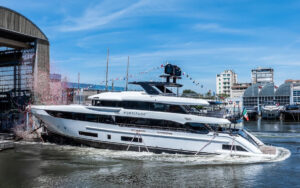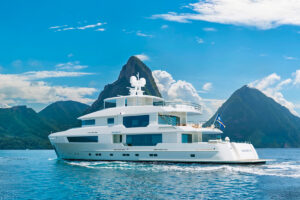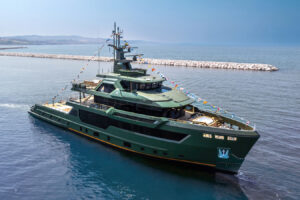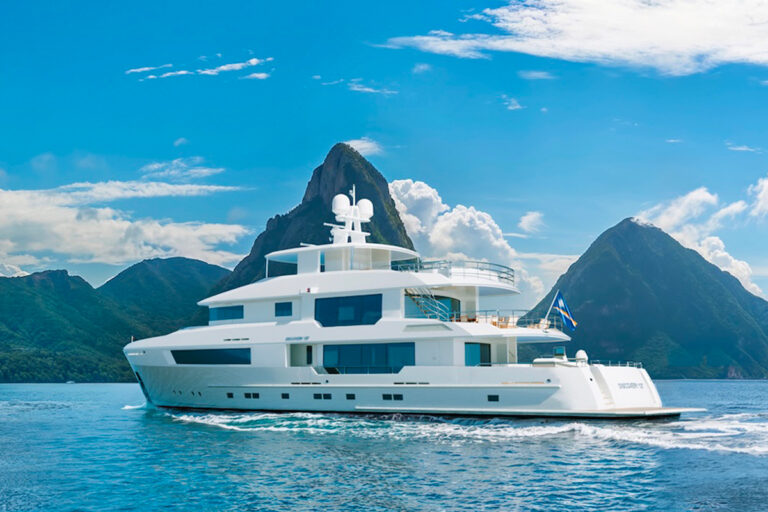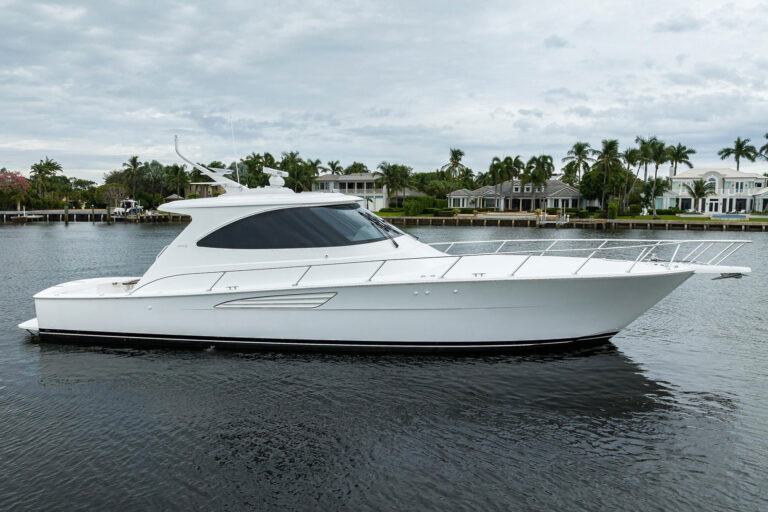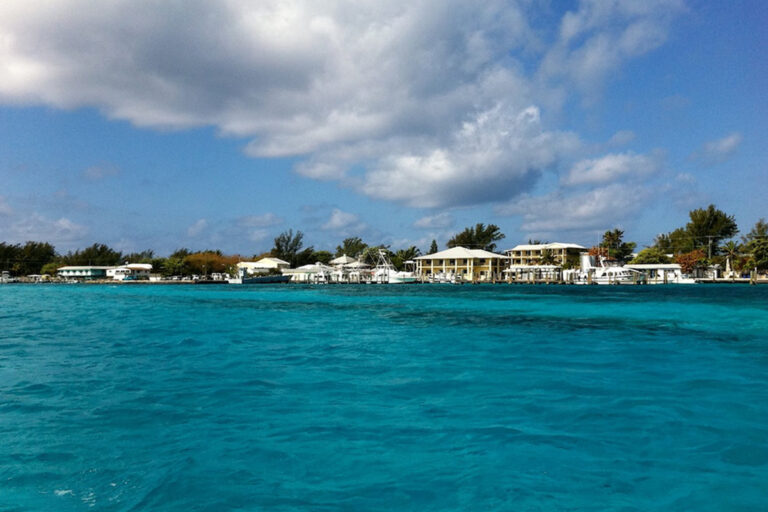
bertram410445.jpg
Sailfishing is gentlemen’s fishing, at least here in South Florida. The bite often starts around 10 a.m., so there’s no need to be out at dawn, and any fish caught are simply released: no mess to clean back at the dock. To me, it’s the perfect distraction for a few hours—like golf, but without the walking. So when an opportunity came to test the new Bertram 410 my first question was, “Are you bringing tackle, or should I?”
Bertram’s product development specialist, José Millan, provided tackle, and also showed me through a yacht that evolved from Bertram’s 39-footer with a clear agenda. “We wanted a guest stateroom you wouldn’t be ashamed to offer another couple,” Millan said, a nod to the fact that bunk beds like those on the 39 are better suited to kids. “We also wanted a private master head and a good second head.” With those parameters, Bertram settled on 41 feet as the smallest sportfishing boat that can properly quarter two couples overnight.
While accommodations may have driven the design, that’s certainly not the reason one owns a sportfishing boat, particularly a Bertram. So with an afternoon to test the 410’s mettle, we ran through performance tests in Biscayne Bay, then slipped around the bottom of Key Biscayne in search of rough water and sailfish.
With the optional 600-hp Cummins diesels, we topped out just a bit over 30 knots, while cruising at around 26 or 27. But as we left the protection of Cape Florida, the stiff easterly breeze blowing against the outgoing tide proved this boat could maintain her speed even in a short, steep chop. One might assume this comes from hull shape, but Millan explained that Bertram also pays close attention to weight: “The ride is a function of the running trim of the boat-we’re able to get the water to break farther aft, and we control the angle of the bottom at that point to give us a smooth ride, and also to throw spray to the sides.”
I’d already noticed we hadn’t taken any spray on the enclosure, despite the solid three-foot seas. Now, taking Millan’s comment as an invitation, I turned slowly to port to see how dry this 410 really was. We were fully beam to the sea before I salted the isinglass, and on any course I chose, from a head sea to a following sea, the 410 was a pleasure to run. Guests will be equally pleased with the boat’s ride; the U-shaped seating ahead of the console and companion seat next to the helm chair provide plenty of room on the bridge.
At the helm, sliding Plexiglas doors protect electronics from the elements. While Bertram’s instrument panel takes up quite a bit of real estate, which shifts navigation displays away from the helmsman, the 410 still has room for two large 12-inch displays and more. Our test boat included one Raymarine E120 multifunction display for the radar, fishfinder, and plotter; a Northstar 6100i GPS; Furuno RD30 depth and sea temperature display; and an Icom VHF-and had plenty of room to spare. The 410 bridge also includes an insulated drink box and dedicated life raft stowage under a seat.
Testing nearly complete, it was time to wet the lines. Millan took the helm and I headed to the cockpit with Ken Hinsley, a local charterboat captain who’d come to help with the fishing. Cabinets along the front of the cockpit held a freezer, bait prep station, tackle drawers and engineroom access, all as it should be. But when I reached for live bait, I discovered Bertram had done some rethinking.
The box in the center of the transom-typically a bait well-held cold drinks. In fact, the Eskimo icemaker is plumbed here, where ice can easily be transferred to the athwartships fishbox beneath the cockpit sole. The live well is forward, on the starboard side, a much more sensible location for tournament fishing.
Bertram also rethought the engine and machinery spaces aboard. Knowing the boat would be largely owner-operated, everything from plumbing to electrical systems was simplified wherever possible. To provide easy access, the machinery space was split in two: The area forward of the cockpit, under the saloon, contains only the two main engines and related components, like fuel systems and sea strainers, while the area aft, beneath the cockpit, houses the generator, air conditioning compressors, and various pumps and machinery. Large cutouts in the bulkhead between these two spaces allow inspection and access outboard of the engines. Huge gasketed hatches in the cockpit and cabin soles can be unbolted and removed in just a few minutes when needed. Bertram also carefully considered fuel placement, opting to locate 540 gallons of fuel in one tank just ahead of the engines, a central location that ensures a consistent running angle as fuel is consumed.

| | |
Since the 410’s design revolves around its two staterooms, the interior tour properly starts in the master stateroom. All the way forward, this includes an island queen berth, as well as generous stowage in drawers, cabinets, and two hanging lockers. Clean lines and rich, two-toned cherry cabinetry show Ferretti’s Italian influences; other European-inspired details, such as ventilated bed platforms that allow mattress bottoms to breathe to eliminate mildew, may go unseen, but you’ll feel the difference.
The master head, to port, is spacious, which must be counted as surprising when the size of the boat is taken into account. A frosted glass and stainless-steel door for the stall shower, mirrored overhead, teak sole and fine cabinetwork are handsome, and again suggest Ferretti’s hand.
The guest stateroom, to starboard and aft of the master, features twin beds. You will certainly feel no shame in offering this stateroom to your guests. The compromise comes in the stateroom’s diminished headroom as it extends beneath the main cabin sole in the aftermost few feet. Stowage is also sacrificed, with only a hanging locker and one small drawer, although newer boats have reportedly already addressed this by utilizing some unexploited voids in the nightstand and under the beds. (In fairness to Bertram, I was aboard the prototype.)
The guest head, which can be entered either directly from the starboard stateroom or from the companionway, is only slightly smaller than the master head. The only real concession to space here is the exclusion of a separate stall shower. Instead, acrylic bi-fold doors create a shower enclosure when needed, which is a more elegant and refined solution than the ubiquitous curtain and overhead track. All in all, I’d say Bertram meets their two-couple objective well.
Abaft the accommodations, the galley occupies the port forward area of the main cabin. While it is one step lower than the saloon, the galley does not feel isolated, perhaps because it is oriented at a 45-degree angle to the boat-which goes to show how a seemingly inconsequential design change can make a major difference in tying spaces together. The galley features a two-burner cook-top, microwave oven, under-counter refrigerator, and plenty of cabinets and drawers. The huge void beneath the galley’s teak and holly sole increases stowage capacity, and a large pantry cabinet offers the options of becoming either a freezer or a combination washer-dryer.

| | |
Across from the galley, on the starboard side, the L-shaped dinette is raised one more step above the saloon to create room for the second stateroom below, yet, as with the galley, this extra step doesn’t lessen the open feeling of the cabin. The saloon includes an L-shaped settee to port, and cabinets on the starboard side accommodate the electrical panels as well as the entertainment center. Large side windows offer sweeping views of the harbor, while cherry blinds provide privacy. The aft window is enormous. It’s sized to allow a Cummins engine through, should it become necessary, but the real benefit is in keeping an eye on the action in the cockpit.
Miami has long been a favorite place for sailfishing. It’s at the junction between the barrier reef and inshore shallows of the Florida Keys, and the Gulf Stream-swept beaches of Ft. Lauderdale and Palm Beach. Bridging these two ecosystems seems to attract sailfish, but as my day ended, would there be time to find one? Sort of. In what was consciously the last few minutes of fishing, a fish came up on the right short. I fed it and then came tight on the sail, but it spit the hook after just a few jumps. A disappointment, yes, but I have to confess it was still a lot more fun than golf.
Contact: Bertram Yachts, (305) 633-8011; www.bertram.com; www.ferrettigroup.com.

